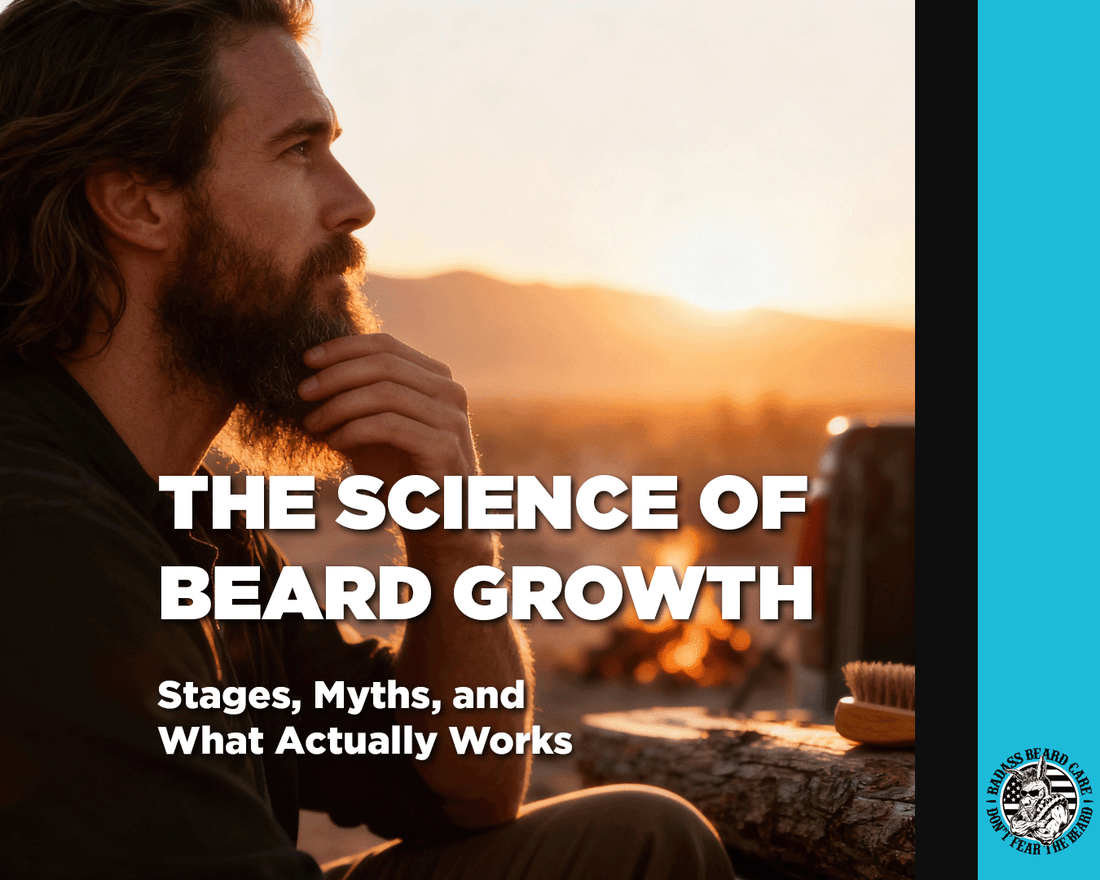TL;DR: Beard growth happens in stages and depends on genetics, hormones, and consistency. You can’t force follicles to grow, but you can maximize your beard’s potential with patience, proper care, and products that support healthy skin and strong hair — like beard oil, balm, and butter.
Introduction
Every man who grows a beard eventually wonders: how fast should this thing grow, and why is it patchy in some spots? Beard growth is as unique as your fingerprint. The good news is that science explains a lot about how your beard grows, what affects it, and how you can help it reach its full potential. This post breaks down the stages, the myths, and what actually works.
What is the 3 month beard rule?
The three-month beard rule means giving your beard a full 90 days to grow before judging it. During that time, your facial hair fills in naturally and reveals its true growth pattern. Many men quit too early because of early patchiness or itchiness, but patience pays off and your beard needs time to mature.
The “awkward beard phase” (how long, what to expect)
The awkward phase usually hits around weeks 3 to 6 of growth. Your beard might feel uneven, scruffy, or unmanageable. This is completely normal. Stay patient, keep it clean, and use beard oil daily to prevent itch and dryness. This phase passes faster than you think if you stick to your care routine.
Timing of filling in / patchy areas
Patchy areas often fill in between months 2 and 4 as slower-growing hairs catch up. Regular brushing helps train your beard to grow in one direction, and beard oil keeps hair and skin healthy so those thinner areas blend better over time.
Beard hormones (androgen, testosterone)
Your beard growth is influenced by androgens, primarily testosterone and DHT (dihydrotestosterone). These hormones tell your follicles to produce thicker, darker hair. Most men have enough testosterone for full growth and it’s usually genetics and patience that make the real difference.
Does patchy beard mean low testosterone?
Not necessarily. A patchy beard doesn’t automatically mean low testosterone. In most cases, it just means some follicles are less sensitive to hormones or grow at different speeds. Beard oil, a balanced diet, and good sleep can all help support optimal growth conditions.
Age when beards usually fill in
Beards can continue to develop well into your 30s. Most men start seeing their fullest growth between ages 25 and 35. If your beard feels thin in your early 20s, don’t stress about it. Time and proper care often fill it out naturally.
What stimulates beard growth?
Healthy beard growth starts with circulation and nourishment. Regular exercise, good sleep, and a nutrient-rich diet all help. Massaging beard oil into your skin boosts blood flow and keeps follicles hydrated, creating the perfect environment for strong, steady growth.
Role of nutrition, sleep, stress
Your beard reflects your overall health. A diet rich in protein, vitamins B, D, and E, plus zinc and biotin, supports stronger hair. Lack of sleep or high stress can slow growth and cause breakage. Rest and recovery are just as important as grooming products.
Can beard oil (or topicals) grow a beard?
Beard oil doesn’t create new hair follicles, but it nourishes existing ones to grow stronger and healthier. Consistent use helps your beard grow evenly by keeping your skin balanced and hydrated. For men with patchy spots, it can make the difference between scruffy and solid.
Supporting growth with your product line or kits
Badass Beard Care products are built to maximize your natural growth. Start with Beard Oil for daily hydration, follow with Beard Balm for control, and use Beard Butter at night for deep conditioning. These keep your beard soft, strong, and growing evenly.
How to tell if your beard will fill in?
Look at your sideburns and jawline. If hair grows densely there, you’ll likely fill in over time. Check family traits too genetics play a big role. Most men see major improvement after a few months of consistent care and brushing.
Does an itchy beard mean it’s growing?
Yes, in many cases it does. Itchiness is often caused by new hair breaking through the skin and a lack of moisture. It’s a sign of progress. Use beard oil daily to soothe irritation and help your beard grow comfortably.
When to shave or not to during growth (neckline rules)
Don’t shave everything off during early growth. Instead, clean up your neckline and cheek lines to keep your beard looking intentional. A good rule: keep your neckline about two fingers above your Adam’s apple and avoid trimming your main growth too soon.
Typical timelines per beard thickness
Thinner beards may take 3 to 4 months to look full, while thicker beards might fill in within 6 to 8 weeks. Everyone’s growth timeline is different. What matters most is sticking with your routine and letting your beard develop naturally.
Handling patchiness (styling tricks, product support)
Use balm or butter to shape your beard and fill in lighter spots visually. Brushing daily trains your hair to grow in the same direction, helping patchy areas appear fuller. Consistency in care is key. Believe me, your beard will thank you.
When to seek dermatology or hormone check
If your beard growth hasn’t changed at all over a long period, or if you have hair loss elsewhere, it might be worth consulting a dermatologist. They can rule out hormonal or skin issues and recommend healthy solutions.
Conclusion
Beard growth is part science and part patience. You can’t force genetics, but you can create the perfect conditions for a fuller, healthier beard. Take care of your skin, use beard oil daily, eat well, and give it time. Every great beard is built through consistency and confidence.
Recommended Products:
- Beard Oil - Daily hydration and growth support
- The Original Badass Beard Balm - Shape and protect your growth
- The Original Badass Beard Butter - Deep conditioning overnight
Want more tips for dealing with tricky beard phases? Read Fixing a Scraggly or Wiry Beard: Expert Tips for a Softer, Fuller Look.







